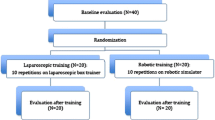Abstract
Background: This study assesses the acquisition of skill and the learning curve associated with the performance of the clip-and-cut task on the Xitact LS 500 virtual reality (VR) simulator in laparoscopic cholecystectomy.Methods: A group of 33 residents and interns with no previous laparoscopic experience participated in the study. All participants received a 1-h familiarization tour on the simulator. Thirty participants completed a full course of 30 simulation runs over 3 days (10 runs per day). The outcome parameters were a previously validated sum-score and time to complete performance. Results: Group demographics were similar. Of the participants who completed the full study, 16.7% appeared to have such a high level of innate psychomotor abilities that they were considered proficient in the task immediately after the initial familiarization tour. Most participants (63.3%) had a moderate level of innate abilities, and their performance improved through repetitive VR training. In our study, 20% of the participants had such a low level of innate abilities that they were unable to achieve an acceptable performance in our minimal-access surgery (MAS) simulation.Conclusions: Learning curves cannot be assessed by examining the repetitive training of only one person. There seem to be four different performance profiles, reflecting the fact that some people are more adept than others to be trained by MAS procedural VR simulation. For participants receptive to training—63.3% in this study—proficiency in the task occurs after ~25 simulative runs.










Similar content being viewed by others
References
MR Ali Y Mowery B Kaplan EJ De Maria (2002) ArticleTitleTraining the novice in laparoscopy: more challenge is better . Surg Endosc 16 1723–1736 Occurrence Handle10.1007/s00464-002-8850-6
PG Bevan (1986) ArticleTitleCrafts workshops in surgery. Br J Surg 73 1–2
J Coleman CC NDuka A Darzi (1994) ArticleTitleVirtual reality and laparoscopic surgery. Br J Surg 81 1709–1711 Occurrence Handle1:STN:280:ByqC38fntlQ%3D Occurrence Handle7827924
PH Cosman PC Cregan CJ Martin JA Cartmill (2002) ArticleTitleVirtual reality simulators: current status in acquisition and of surgical skills. Aust AN Z J Surg 72 30–34 Occurrence Handle10.1046/j.1445-2197.2002.02293.x
D Deziel KW Milikan SG Economon A Doolas ST Ko MC Airan (1993) ArticleTitleComplications of laparoscopic cholecystectomy: a national survey of 4,292 hospitals and an analysis of 77,604 cases. Am J Surg 165 9–14 Occurrence Handle1:STN:280:ByyC3MfosVM%3D Occurrence Handle8418705
A Farrell (2002) ArticleTitleCan virtual reality be used to measure and train surgical skills?. Ergonomics 45 362–379 Occurrence Handle10.1080/00140130110120529 Occurrence Handle12028721
A Gallagher M Satava (2002) ArticleTitleVirtual reality as a metric for the assessment of laparoscopic psychomotor skills. Surg Endosc 16 1746–1752 Occurrence Handle1:STN:280:DC%2BD38jis1CisA%3D%3D Occurrence Handle12140641
Grantcharov TP (2002) Teaching and testing surgical skills on a VR laparoscopy simulator: learning curves and effect of previous operative experience on performance. 10th International Congress of the European Association for Endoscopic Surgery (EAES), Lisbon, Portugal
TP Grantcharov L Baruran P Fuch-Jensen J Rosenberg (2003) ArticleTitleLearning curves and impact of previous operative experience on performing on a virtual reality simulator to test laparoscopic surgical skills. Am J Surg 185 146–149 Occurrence Handle12559445
JM Hamdorf JC Hall (2000) ArticleTitleAcquiring surgical skills. Br J Surg 87 28–37 Occurrence Handle10.1046/j.1365-2168.2000.01327.x Occurrence Handle1:STN:280:DC%2BD3c%2FnsVKksQ%3D%3D Occurrence Handle10606907
SW Melvin JA Johnson CE Ellison (1996) ArticleTitleLaparoscopic skills enhancement. Am J Surg 172 377–379 Occurrence Handle10.1016/S0002-9610(96)00186-9 Occurrence Handle1:STN:280:ByiD38jjvFE%3D Occurrence Handle8873534
MJ Moore CL Bennett (1995) ArticleTitleThe learning curve for laparoscopic cholecystectomy. Am J Surg 170 55–59 Occurrence Handle10.1016/S0002-9610(99)80252-9 Occurrence Handle1:STN:280:ByqA3MzotVc%3D Occurrence Handle7793496
JH Peters EC Ellison JT Innes (1991) ArticleTitleSafety and efficacy of laparoscopic cholecystectomy. Ann Surg 312 3–12
CR Ramsay et al. (2001) ArticleTitleStatistical assessment of the learning curves of health technologies. Health Technol Assess 5 1–98 Occurrence Handle1:STN:280:DC%2BD3M7msVWrtA%3D%3D
MR Satava A Cushieri J Hamdorf (2003) ArticleTitleMetrics for objective assessment: preliminary summary of the Surgical Skills Workshop. Surg Endosc 17 220–2226 Occurrence Handle10.1007/s00464-002-8869-8 Occurrence Handle1:STN:280:DC%2BD3s%2Fms12ruw%3D%3D Occurrence Handle12436236
M Schijven J Jakimowicz (2002) ArticleTitleFace, expert, and referent validity of the Xitact LS 500 laparoscopy simulator. Surg Endosc 16 1764–1770 Occurrence Handle10.1007/s00464-001-9229-9 Occurrence Handle1:STN:280:DC%2BD38jis1eqtw%3D%3D Occurrence Handle12098029
M Schijven J Jakimowicz (2002) ArticleTitleConstruct validity: experts and residents performing on the Xitact LS 500 laparoscopy simulator. Surg Endosc . .
MP Schijven J Jakimowicz C Schot (2002) ArticleTitleThe Advanced Dundee Endoscopic Psychomotor Tester (ADEPT) objectifying subjective psychomotor test performance. Surg Endosc 16 943–948 Occurrence Handle10.1007/s00464-001-9146-y Occurrence Handle1:STN:280:DC%2BD38vgvFGmsA%3D%3D Occurrence Handle12163960
InstitutionalAuthorNameSouthern Surgeons Club (1995) ArticleTitleThe learning curve for laparoscopic cholecystectomy. Am J Surg xx 55–59
P Strorn et al. (2003) ArticleTitleValidation and learning in the Procedicus KSA virtual reality surgical simulator: implementing a new safety culture in medical school. Surg Endosc 17 227–231 Occurrence Handle10.1007/s00464-002-9078-1 Occurrence Handle12399848
KR Wanzel M Ward RK Reznick (2002) ArticleTitleTeaching the surgical craft: from selection to certification. Curr Probl Surg 39 574–659
Author information
Authors and Affiliations
Corresponding author
Rights and permissions
About this article
Cite this article
Schijven, M., Jakimowicz, J. The learning curve on the Xitact LS 500 laparoscopy simulator: profiles of performance. Surg Endosc 18, 121–127 (2004). https://doi.org/10.1007/s00464-003-9040-x
Received:
Accepted:
Published:
Issue Date:
DOI: https://doi.org/10.1007/s00464-003-9040-x




